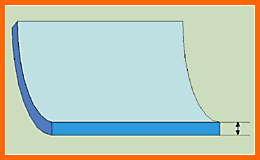Pool liners are essential components of any swimming pool, as they provide a protective barrier between the water and the pool structure. One common question that many pool owners have is, “How thick is a pool liner?” The thickness of a pool liner can vary depending on the material used and the type of pool. Let’s explore this topic further to understand the importance of pool liner thickness.
The Importance of Pool Liners
Before delving into the thickness of pool liners, it’s crucial to understand why pool liners are essential. Pool liners serve several purposes, including:
- Providing a watertight seal: Pool liners prevent water from leaking out of the pool, maintaining the water level and preventing damage to the pool structure.
- Protecting the pool structure: Liners act as a protective barrier, shielding the pool walls and floor from damage caused by water and pool chemicals.
- Enhancing aesthetics: Pool liners come in various colors and patterns, enhancing the overall look of the pool and creating a visually appealing environment.
Types of Pool Liners
There are different types of pool liners available in the market, each with its unique characteristics and thickness. The most common types of pool liners include:
| Pool Liner Type | Material | Thickness |
|---|---|---|
| Vinyl Liners | Vinyl | 20-30 mil (0.02-0.03 inches) |
| Fiberglass Liners | Fiberglass | 10-16 mil (0.01-0.016 inches) |
| Tile Liners | Ceramic or Porcelain Tiles | Varies depending on tile thickness |
As seen in the table above, the thickness of pool liners can vary significantly based on the material used. Vinyl liners are the most common type of pool liner and typically range from 20 to 30 mil in thickness. Fiberglass liners, on the other hand, are thinner, typically ranging from 10 to 16 mil.
Factors Affecting Pool Liner Thickness
Several factors can influence the thickness of a pool liner, including:
- Pool Size: The size of the pool can impact the required thickness of the liner. Larger pools may require thicker liners to withstand the water pressure and stress.
- Pool Shape: The shape of the pool, such as curves or corners, can affect the liner’s thickness requirements to ensure a proper fit and seal.
- Pool Usage: The frequency of pool use and the type of activities conducted in the pool can impact the wear and tear on the liner, necessitating a thicker material.
Choosing the Right Thickness
When selecting a pool liner, it’s essential to choose the right thickness based on your pool’s specific requirements. Here are some tips to help you choose the appropriate liner thickness:
- Consult with a Pool Professional: Seek advice from a pool professional or installer to determine the ideal liner thickness for your pool.
- Consider Pool Usage: If your pool experiences heavy usage or specific activities, opt for a thicker liner to enhance durability and longevity.
- Review Material Durability: Different materials offer varying levels of durability. Consider the material’s lifespan and wear resistance when selecting the liner thickness.

Credit: www.familypoolfun.com

Credit: royalpoolsandmore.com
Maintaining Pool Liners
Proper maintenance is crucial to extend the lifespan of your pool liner. Here are some maintenance tips to help preserve your pool liner:
- Regular Cleaning: Clean your pool liner regularly to prevent the buildup of dirt, debris, and algae.
- Monitor Chemical Levels: Maintain proper water chemistry to prevent damage to the liner caused by imbalanced chemicals.
- Inspect for Damage: Routinely inspect the pool liner for any tears, punctures, or wear and tear, and address any issues promptly.
Conclusion
In conclusion, the thickness of a pool liner plays a crucial role in protecting your pool and ensuring its longevity. Understanding the factors that influence liner thickness and selecting the appropriate material can help you maintain a secure and visually appealing pool environment. By following proper maintenance practices and choosing the right liner thickness, you can enjoy a well-protected and aesthetically pleasing swimming pool for years to come.





